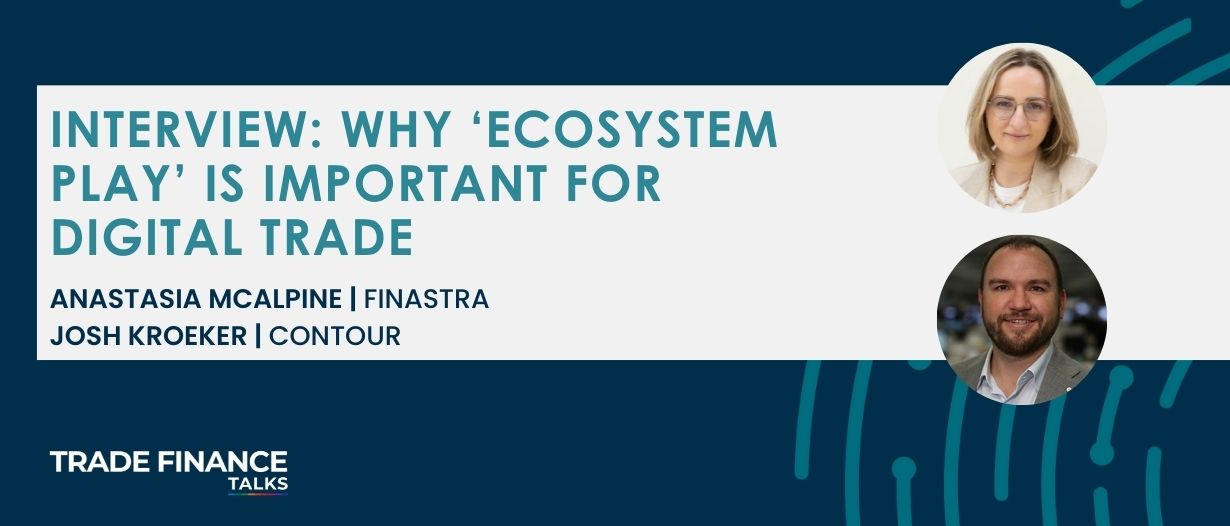Digitally-facilitated trade finance ecosystems where collaboration reigns may be the next frontier for the industry.
Estimated reading time: 8 minutes
Recent times have seen fintech companies collaborating more frequently. But why is this important for trade digitisation?
Trade Finance Global’s (TFG) Annie Kovacevic sat down with Finastra’s Anastasia McAlpine (AM) and Contour’s Josh Kroeker (JK) to find out more.
What is Finastra’s Fusion Trade Innovation platform and how does it work with banks’ systems and internal workflows?
AM: Finastra’s single digital working capital finance platform supports the front-to-back automation and management of both documentary trade (for example, letter of credits (LC), collections and guarantees) and supply chain finance products.
Fusion Trade Innovation is our best-in-class, multi-award-winning WCF booking engine; when combined with Fusion Corporate Channels we provide a front-to-back, end-to-end trade, and working capital finance solution. It can be deployed on-premise, or on the cloud with integration to an ecosystem of services that supports the digitalisation of the full transaction lifecycle.
The applications have open application programming interfaces (APIs) that connect via FusionFabric.cloud to the wide ecosystem of networks, fintechs, and third-party solutions. This redefines the WCF landscape and opens new business opportunities for banks and financiers.
How does Contour’s network digitalise the LC and how do banks benefit?
JK: Contour and its founding banks believe that the cornerstone of digitisation is connectivity, and today there is a lack of common connectivity between banks, corporates, and the physical supply chain that make up the trade finance ecosystem.
Contour aims to change that by providing connectivity to the participants of an LC transaction, either as direct network members, as in the case of banks and corporates, or through partnerships and interoperability with physical supply chain network solutions.
This type of connectivity historically has required a centralised database with all the world’s data in one place. Still, with Contour’s decentralised technology, we have removed this hurdle to adoption in a profound new way.
From this foundation of common connection and decentralised data, banks will finally be able to shift away from unsecured communication and paper documents towards a more streamlined, automated, and digital trade offering.
This is important for banks to lower the cost to serve for trade finance products and, just as importantly, to improve the user experience of accessing trade finance products.
These two changes combined can drive an increase in the size of their trade finance businesses and the accessibility of trade finance to a wider range of corporates.
Can you provide an overview of the Contour and Finastra tradetech partnership, what was the initial rationale?
JK: Partnerships have always been a major part of Contour’s plan to increase the digitisation of trade finance, therefore this industry collaboration will be key to our mutual success in that goal.
We know that banks have invested a significant amount of time and money in their trade finance software relationships, and it only makes sense that they should be able to access the Contour network and its many benefits using the software user interface of their choice.
For many banks, that choice is Finastra, and we are very pleased to see Finastra taking such proactive steps to connect their clients to the Contour network.
Why is Finastra partnering with other fintechs, and why is this ‘ecosystem play’ important for transaction banking?
AM: A typical trade transaction involves many data touch points across various often international parties; these may include buyers, sellers, financiers, insurance, freighters, port authorities, customs and many more.
With so many varying denominations, friction can occur in the process, in addition to; lack of visibility, delays, and uncertainty among transaction parties.
Digital technologies hold immense transformative potential for global trade. The finance industry remains largely paper-based, and technology can help financial institutions (FIs) to reduce costs, improve operational efficiency, and reduce risks.
Finastra’s goal is to deliver a solution that digitalises the trade transaction end-to-end. This will be achieved through pre-integrated digitalisation capabilities offered through an ecosystem of fintechs and marketplaces.
Clients will be provided with completely harmonised, future-proof access to process automation capabilities optimising overall time and cost to serve. Through a network of selected partners, we offer a range of digital trade capabilities that all improve the efficiency of banks’ trade operations and add value by focusing on business growth. Clients will then be able to innovate at scale at a much lower cost.
Finastra’s integrations with fintech solutions, such as Contour, mean that clients can deliver innovation at speed. This is because they have access to a growing ecosystem of value-added services that don’t impact core, pre-integrated solutions.

Why are banks digitising their backend and frontend trade finance systems, and how is this working in reality?
AM: Digitisation is not simply a trend but a disruptive change to the way trade and working capital finance operate.
Many FIs have had difficulties in accessing documentation throughout the pandemic due to lockdown and quarantine protocols. However, coming out of the height of the pandemic, we are seeing an increased push for fully digitised global trade and working capital finance.
JK: Digitising trade finance is a two-pronged problem. One is to ensure all the communication is digital (i.e., remove paper applications at the counter and instead use phone calls to clarify errors), and two is removing paper from the process by working with physical supply chain partners to eliminate the need for paper evidence.
Networks like Contour can enable new digital communication connections, and with partners like Finastra, further banks and corporate customers can be reached. Contour is also a multi-bank platform, allowing larger corporations to connect with their panel of banks.
Removing paper is a challenge. To achieve this, banks need to digitise through an ecosystem play while smoothly integrating digital channels to provide a coherent and logical end-user experience.
The end goal remains the same––a lower cost-to-serve product set with improved user experience for corporates. This is what can lead to sustainable growth in trade finance and a more inclusive and sustainable trading world as a result.
Ideally, all of this must be delivered to a single market standard, but we have to start somewhere and not risk waiting for a perfect starting point.
Could you give an overview of how a Finastra customer (bank) could extend its existing workflows using Fusion Trade Innovation to use the Contour network?
AM: Our collaboration with Contour enables the automation of transaction initiations, as well as enabling compliance checks and better document examination across trade instruments and transport tracking offered by our other partners.
All of these components work together to enable automated, frictionless transaction processing that reduces time and cost, thereby supporting faster business growth.
Most importantly, it improves customer support and visibility delivered by Contour.
Some of the key benefits that clients can achieve through the Finastra-Contour collaboration are:
- Transform the LC process by having all participants on one platform.
- Increase adoption of digital documentation––streamlining workflows by reducing reliance on paper-based documents.
- End-to-end digital LC solution that is cost-effective, fast, and secure––offering full transparency and visibility of the entire transaction
The transformation of customer service and transaction processing has a significant impact on operational costs. In a 2020 International Chamber of Commerce (ICC) survey, banks estimated that digitisation would provide an 11%-30% reduction in overall operational costs across the subsequent three years.
How does this work with FusionFabric.cloud?
AM: There may be a preconception that new working capital solutions should be managed ad-hoc by fintechs.
However, the reality is that the complexity of adding new products is incredibly challenging, expensive, and risky in a disjointed multi-system solution.
Although other providers may offer APIs and are exploring platform delivery models, the majority of services would need bespoke integration and ongoing maintenance, which limits the ability to innovate at speed and also limits the choice of solutions.
Our digital trade ecosystem strategy via Finastra’s FusionFabric.cloud is based on harnessing open ecosystems for fast innovation in trade and working capital finance.
The open APIs provide an ecosystem for fintechs, FIs, and other market players with an opportunity to create differentiated offerings through a series of pre-integrated complimentary digital solutions.
For example, the Contour collaboration allows our bank clients and their corporate clients to simplify the LC process on one multi-bank platform, maximising business efficiency and offering new business opportunities.
Finastra clients can also create and manage digital original documents, as well as using intelligent document recognition, data screening, and business analytics using Optical character recognition (OCR) and artificial intelligence (AI)/machine learning (ML).

Is there competition (or coopetition) with Finastra and other back-office providers to work with Contour?
AM: As far as we are aware, this is the first collaboration of its nature on the market. Finastra believes in openness and will continue investing driving innovation which will complement our solutions, ultimately helping our banking clients to improve their business efficiency and success.
JK: Contour is an open network and we are happy to work with other providers, but it is great to have a forward-thinking partner in Finastra that sees the value in being first to this space, and the benefit of offering their clients a more holistic and connected approach.
What’s next for the future of tradetech collaborations and who will drive this change?
AM: The transition to the digital norm requires constant collaboration between tradetech providers.
This way, businesses and banks can improve the efficiency of their trade operations through automation and unlocking customer value.
Collaboration with the Contour team is an example of two complementary solutions being integrated in a seamless way to help clients accelerate their business and realise digitisation ambitions. It eases digital adoption and transformation.
This foundation acts as a catalyst toward the transformation of the trade finance industry, forming a scalable solution that brings the benefits of digitisation to an international trade ecosystem.
Finastra is committed to the vision of digitising global trade that, among the abovementioned, can also deliver ‘trade for good’ in an advanced sustainable way.
This can be achieved through optimising trade transaction processes through innovative technologies that reduce the use of paper, improve access to financing for small- and medium-sized enterprises (SMEs), and achieve many other global environment, social, governance (ESG) benefits.
We look forward to working closely with more like-minded fintechs and extending the Finastra ecosystem.

























